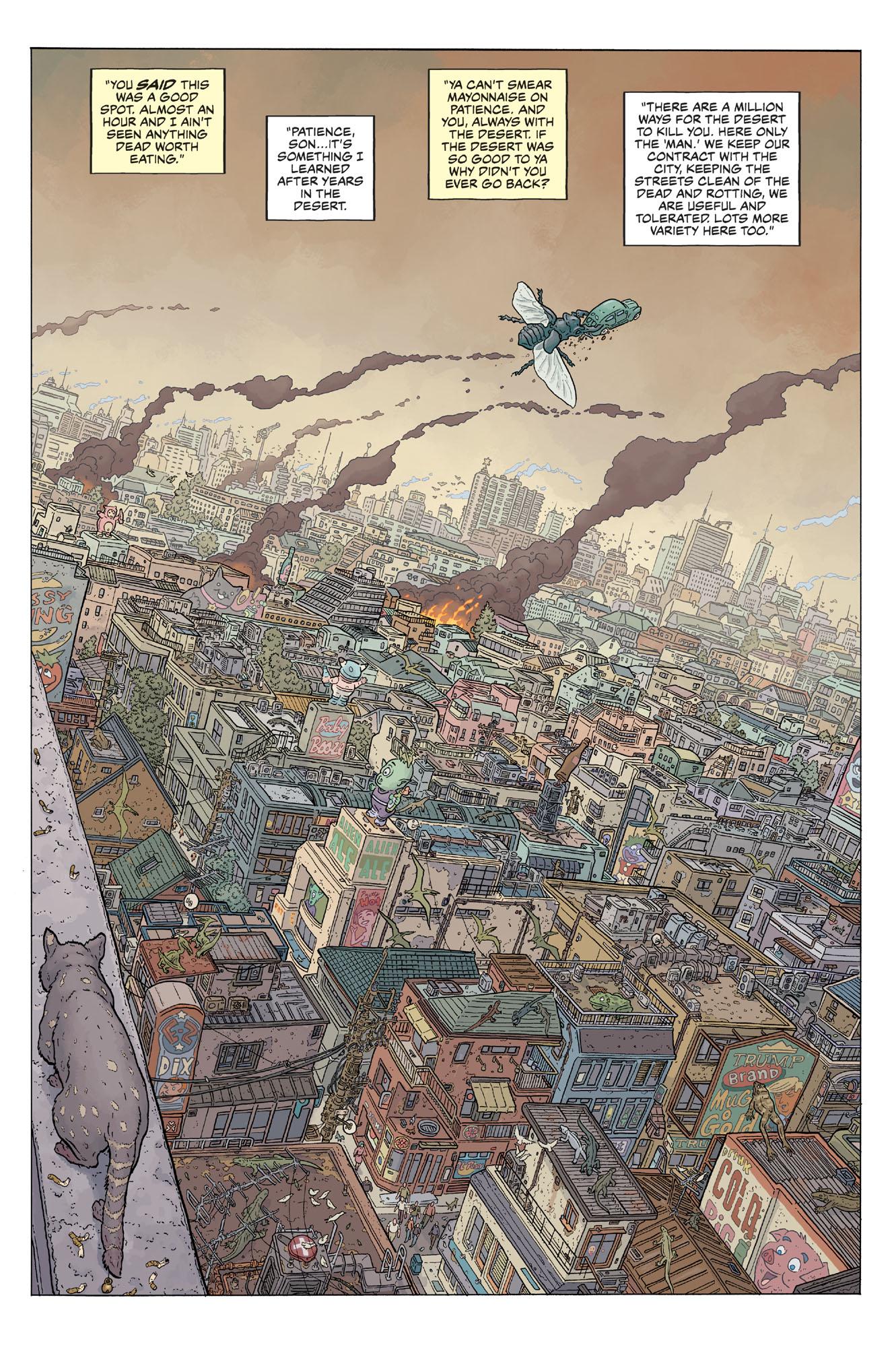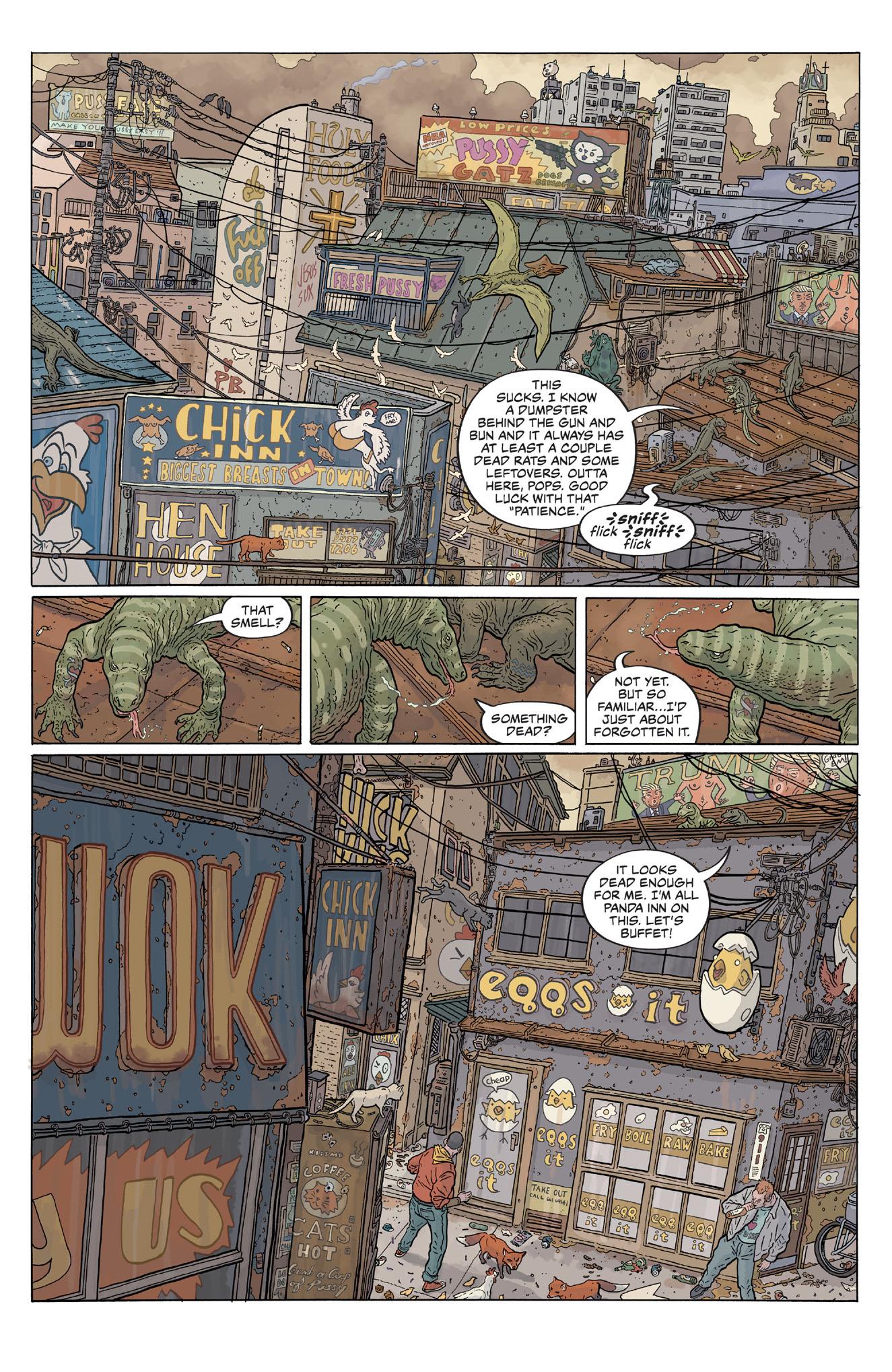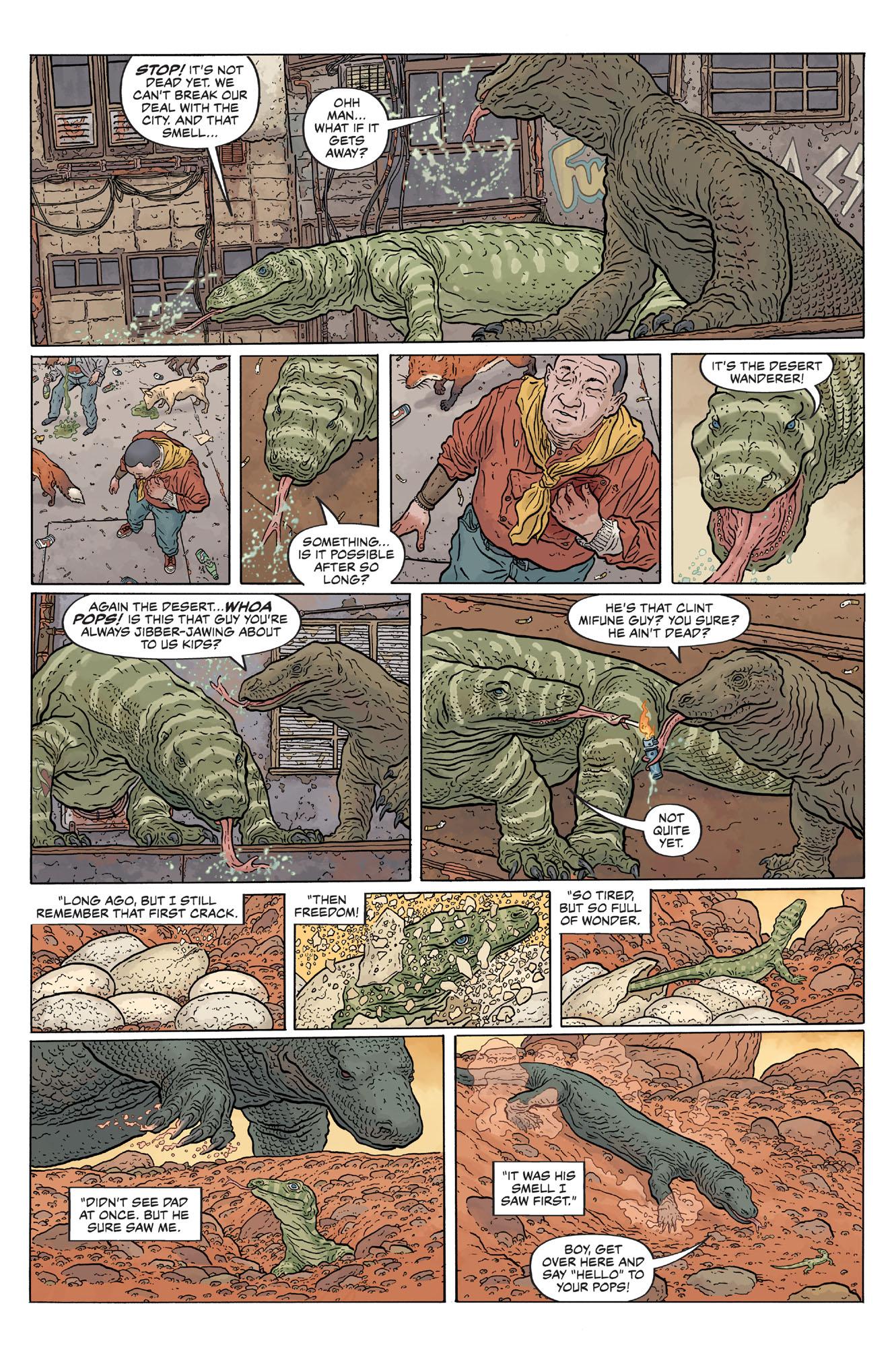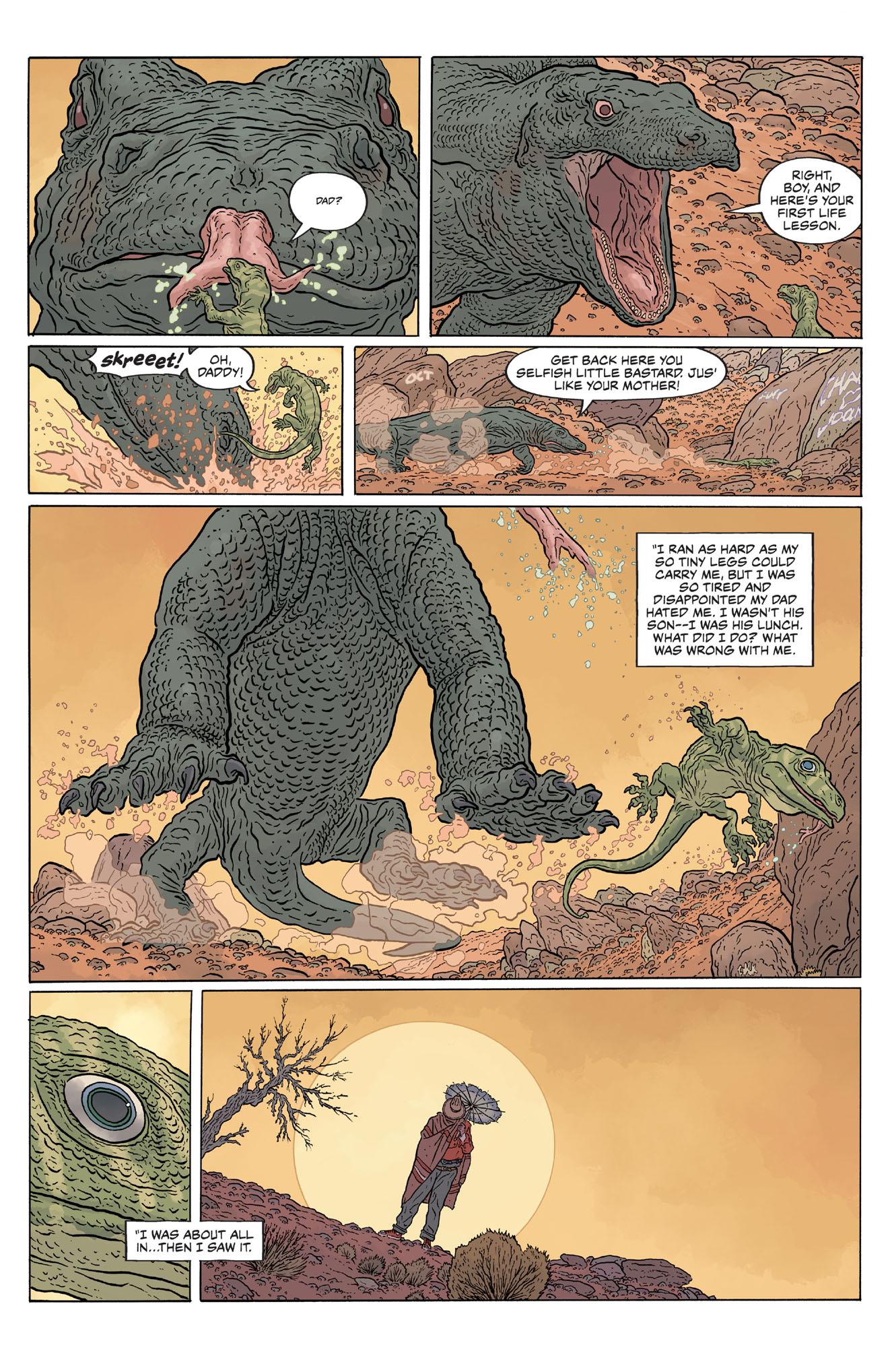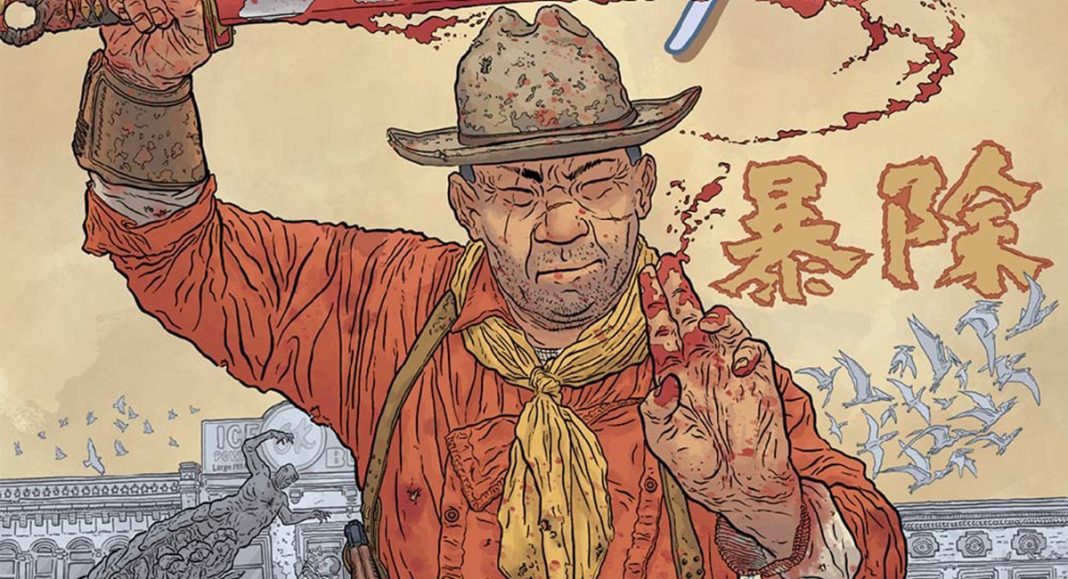By Eric Buckler
Shaolin Cowboy: Cruel to Be Kin by Geof Darrow was released as a hardcover graphic novel by Dark Horse Comics in August. The graphic novel includes a guest cover art gallery and sketchbook.
Shaolin Cowboy tells the story of a wandering, taciturn monk who is a supernaturally gifted kung fu fighter and wields a cool parasol sword and decapitator hat. The cowboy is the constant target of violent crime from grotesque sci-fi monsters and the like, sometimes for no real reason. Occasionally, they want revenge because of his previous violent reactions to their initial attacks.

Cruel to Be Kin introduces Komodo dragons, giant steampunk squids driven by super tiny supervillains, and racist idiot hitmen to this already crowded and wildly imaginative universe.
Darrow was born and raised in Cedar Rapids, IA, and started his illustration career in advertising and animation after graduating from the Chicago Academy of Fine Arts. He burst onto the comics scene with Bourbon Thret, which was initially published in France, and then Hard Boiled, a violent, detailed collaboration with Frank Miller that launched Darrow as one of the most memorable cartoonists of his generation.
Stated simply, Darrow is an extremely interesting person. He offers relentlessly unique, captivating anecdotes, and bizarre esoteric trivia in response to any questions or conversational opportunities put in his path. The sense of humor behind his timing and material is just as unique and bizarre; it almost seems too brash to work, but it’s actually full of subtle orchestration that works like a dream. His artistic and storytelling creativity are direct manifestations of that same interesting personality. It is a thrill to be inside the creativity that made the same wild worlds on his pages.
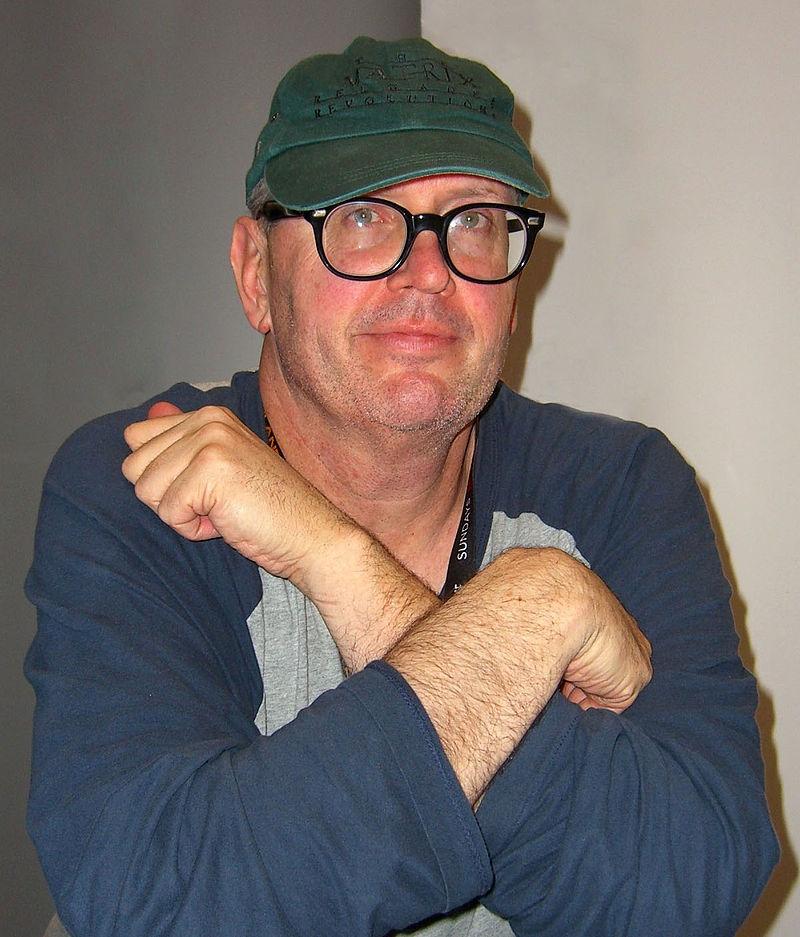
By Luigi Novi, CC BY 3.0,
Poetic efforts aside, it was just awesome talking to someone who has worked with an all-star menagerie of comic book royalty (where he holds just as much legendary provenance), including Jack Kirby, Moebius, Frank Miller, Steve Skroce, and Dave Stewart.
Darrow might actually outright dismiss any of these compliments. Is it humility? No, he just thinks he draws too slowly and has goofy characters. — Geof Darrow in Bretagne, France. Eric Buckler in Seattle, WA. June 4, 2023:
Eric Buckler (BUCKLER): What part of France do you live in?
Geof Darrow (DARROW): Ahh, it’s a little south and very west of Paris, if you look on a map, in fact, it’s the farthest western point on the European continent. It sticks out in the ocean. The area’s called Bretagne, I don’t know if you’ve seen Asterix?
BUCKLER: Yeah.
DARROW: That’s where his character’s from.
BUCKLER: Oh! Neat. I was in France for the first time a few years ago. Didn’t make it over there.
DARROW: I’d be surprised if you did [Laughs]. The place I live, the boulangerie, has a tiny little bar attached that maybe 4 people could fit in? [There’s] a little grocery store, a beauty salon. I think there is someone who cleans up cats and dogs, it’s like a grooming place. And a church.
BUCKLER: That’s an interesting mix of things.
DARROW: Very. I would be able to get my haircut and my dog cleaned.
BUCKLER: [Laughter] Then stop and get some groceries. How long have you been living there?
DARROW: Three years. Wait… four years! I’ll be damned.
BUCKLER: Where were you before that?
DARROW: Oh, I’ve lived in France before. I lived in Paris for a while. Went to Normandy and then back to Paris. Then I went to Chicago. I lived in Chicago for 13 years. I left there in 2018 to come here. Grew up in Iowa. Lived in Los Angeles. I’ve lived all over.
BUCKLER: You started illustrating in advertising in Chicago, correct?
DARROW: I worked for an audio/visual company. They did like inter-company advertising. Once a year, [companies] like McDonald’s would have these sales meetings. They’d pick some area where they would get all their sales reps to come to, like San Francisco or LA, during the winter. Then they’d have a sales presentation like, “This year we’ll sell even more hamburgers!” [Laughs]. They would have these speeches and I drew a lot of cartoons for that. You know, like sales graphics. They had these 35mm slides and they had to be just so. They were so annoying and time-consuming [Laughs]. They had to sync up all the time. It was just not a highlight.
BUCKLER: [Laughs]

DARROW: But, it was a job.
BUCKLER: Whatever can get you into the field?
DARROW: Yeah!
BUCKLER: So when was the first time you created a comic of your own?
DARROW: Oh, when I was a kid I tried to do comics. I think I had one called Dave Danger? [Laughs]. It would always just be like one drawing; Oh now he’s being attacked by a giant vulture, now he’s fallen into quicksand, now he’s fighting a giant snake. That kind of crap. I was buying comic books. Then, I guess I would have been in 6th grade, I discovered Marvel Comics and would try and copy them. I would try and copy like a Jack Kirby comic, but you know, real large! I never finished one [Laughs]. It wasn’t ’til I went to art school that I finished a single comic. Well, I did finish one story. We did like a fanzine my senior year, it had like a three- or four-page story in it.
BUCKLER: You went to Hanna-Barbera in LA after Chicago, right?
DARROW: Yeah. I moved out there because I kinda figured that those Hanna-Barbera cartoons in the ‘80s were just so bad! [Laughs]. I figured even someone with a limited ability could probably get a job at that place. I actually just figured, it wasn’t just that Hanna-Barbera was bad, but there was just a lot of animation out there like Filmation and Hanna-Barbera.
I actually started at Filmation. They fired me after the three weeks. They had us do, or try to do, storyboards. I had never done them before, and on top of that, they did a lot of stock animation at Filmation. They had all these key pieces of animation and you were supposed to plug that in whenever you could. It’d be like Flash Gordon running across the screen, or jumping, or some bullshit like that. They gave us these big thick books. I mean rough, they were like four inches thick with all the stock animation images. So, when you were storyboarding, you’d look through that to find an image so someone wouldn’t actually have to animate it. We just weren’t fast enough.
So one day, nearly everybody that got hired, all got laid off because we just weren’t fast enough. One of ‘em who actually left was a guy called Paul Smith, he actually left to go do the X-Men!
BUCKLER: Didn’t know that!
DARROW: Dave Stevens was there at that time too.
BUCKLER: Oh, Rocketeer!
DARROW: He was in the layout department, that was where I first met him. My boss there [at Filmation] was a guy named Will Meugniot who drew comics for Eclipse. He did quite a few comics actually.
BUCKLER: A lot of cartoonists!?
DARROW: Oh, there were! Then after that, I went over to Hanna-Barbera. They had a lot of Filipino artists. That’s where I met Jack Kirby. I’d met him before, but not really. Some of the guys just worked for newspaper comics. One of the guys, oddly enough, I didn’t know it at the time — I didn’t cross the t’s and dot the i’s — the guy the Hernandez Brothers loved so much who was drawing Dennis the Menace, he was working there! His name was Owen Fitzgerald.
He was a layout guy, a real nice guy. I was really surprised when [the Hernandez Brothers] were talking and they were talking about this one guy, and I was like, “Oh! Owen!” [Laughs].
There were some of the guys who did like Garfield. There was a guy named Mo Gollub who painted all these beautiful paintings for all those old Dell Comics. He painted the Tarzan covers and painted a lot of the Westerns. He was just brilliant at painting animals.
There was so much talent at Hanna-Barbera and it very seldom ever made it onto the screen cus they would just crank that stuff out as fast as they could. Just to make a profit.
I mean, they did some good stuff. I always liked Johnny Quest, the designs were pretty good. But the stories were just… when I was working on Super Friends, those things were just so horrible.
BUCKLER: Yeah, looking back on some of that kind of material these days…
DARROW: I mean yeah. Kirby was doing character design. God, some of the stuff. He would even do some for Scooby-Doo and they were hilarious! He would just draw the stuff so quick. It wasn’t what you would call, “On Model.” He was really good. They would have to do spaceships and monsters. But at the time, the department I was in was character design and all of that shit, it didn’t look like Kirby.
It wasn’t until he went over to Ruby-Spears where he worked on Thundarr. You can see his touch on Thundarr but you could never see what he did on the kind of stuff that I was working on like the Super Friends stuff or Space Ghost. It all got like, “Hanna-Barbera-ized”.
Mike Sekowsky, who drew like the first 60 issues of Justice League, was there [too].

BUCKLER: Oh, yeah, he’s great! What was it like transitioning into that world with all of that talent? Even though it sounds like a lot of the illustrators were just cranking out the simplified art like you were.
DARROW: I mean, I was really not very good at the job. A lot of the stuff that I did was the stuff that nobody else wanted to do; which was like a pie, a model of a pie, or a car, or a truck, or a weapon, or a hockey stick or like when Scooby-Doo has to be wearing a sombrero.
A lot of it was like basic stuff and they were just changing it a little bit. Like when we were there, they brought in the Wonder Twins. It was like the Wonder Twins looked into a bucket of ice water or something. Like you would draw their faces, mirror-like, in a puddle. I was always on the edge of being laid-off and fired, I just wasn’t good at it.
I worked there for a few years and I just kinda kept out of my bosses way. I worked for this really beautiful woman, Sandra Young, who was a really great artist. Everybody was in love with her and I was kind of her assistant. I would give her my drawings and then [Laughs] she would go in and take ‘em to the boss [Laughs]. Because if I took the same drawing in, he would disapprove of it. But if I gave it to her, and she took it in, it would be okay [Laughs]. I mean, she was like Marilyn Monroe, literally. Her mother was a ’30s movie star.

http://www.celebritydirect.biz/branch/photos.htm
BUCKLER: That’s a pretty charming story.
DARROW: I was just amazed at the people that they had there. Most of them were really sweet.
BUCKLER: So, to sort of switch gears, as far as Shaolin Cowboy goes, does that character have any autobiographical elements in it? Do you base any of your characters on yourself or your life?
DARROW: Not really [Laughs]. I did put one thing in one of ‘em that actually happened to me. The title of the book was Shemp Buffett. There was all these zombies in it. There was a scene when this car is driving by and these guys shout at him.
BUCKLER: Oh yeah, the scene where they’re calling him gay?
DARROW: Yeah and that actually happened to me. I was on Sunset Blvd. and I was working on The Matrix at the time. I was with Steve Skroce, who storyboarded most of The Matrix. By the way, he’s doing a BRZRKR comic that comes out next month (BRZRKR: Poetry of Madness, Boom Studios), actually.
Anyways, we were going into this Sunset Blvd. place where there used to be a Tower Records. As we were going in there, this car of kids goes by and they yell out, “Hey, you’re gay! And he’s your lover!” [Laughs] And they’re laughing! You could tell these kids had been drinking. I turned around and looked at ‘em and I go, “What?”
And they go, “You’re gay!” And they thought it was like the funniest fucking joke they had ever heard. And I said, “You can tell that all the way from there?” And they said, “Yeah!” They were laughing and so I said, “Enjoy that first beer, boys.”
They drove off and that just stuck with me. The stupidity of it! I don’t know if you know what the Algonquin Table is, but these guys just thought they were so witty! I just put it in the comic because it always just stuck with me. God, they thought that was funny. I bet they’re still talking about it, 20 years later. “Remember when we called those guys ‘gay’ on Sunset Blvd.?” [Laughs]
BUCKLER: What year was that?
DARROW: Must have been around 1997 I think? ‘Cuz I worked on all of them [The Matrix movies] and they kind of run together, but yeah.
BUCKLER: Nice, that’s some mature joke telling.
DARROW: [Laughs] Yes, yeah, exactly. George Carlin! [Laughs]
BUCKLER: Can you talk about the genesis of Bourbon Thret and where that character came from initially?
DARROW: He came from… I always liked Japanese samurai films like Zatoichi. I also liked spaghetti Westerns. I just combined the two of them. I mean not exactly, but he kind of is a little bit like Zatoichi. I mean he’s got the sword that’s similar. Not sure if you picked up that, but Shaolin Cowboy is Bourbon Thret.
BUCKLER: Right! That’s why I’m asking.
DARROW: Yeah, I mean at one point in the third book, there’s this point where there’s this messenger from Hell that’s come up to claim him [the Shaolin Cowboy] and take him back, but he can only take him back if he calls him by his real name. And he’s rattling off all these names and I think one of the last things he says is “Bourbon,” and then that character kills him.
You’re the first person to notice that, at least that has said that to me.
BUCKLER: The characters are very similar. There are some differences. He’s almost more jovial, initially, as Bourbon Thret.
DARROW: Yeah. He’s gotten more… As I’ve gotten older, especially with the world we live in, he’s gotten more and more brutal. Even if you look at the first series that Burlyman [Entertainment] did, he’s a little more… as it’s gone on, he’s gotten more and more cynical about people. I guess… like me.
BUCKLER: So, speaking of the evolution of the character, the cityscapes you do in Shaolin Cowboy, Hardboiled, and even the ones in Big Guy and Rusty the Boy Robot, there’s that dystopian element. Do you see your cynicism building in that too? Like a comment on society?
DARROW: Yeah, I guess so, yeah. I’m not trying to… well maybe I am. I don’t… well, I guess maybe I do, especially that last one [Cruel to Be Kin]. If people notice it, they notice it. If they don’t, they don’t. I never have him [Shaolin Cowboy] stop and look in the camera and pontificate about the ills of humanity [Laughs. I think there is enough going on in those backgrounds that you can see that I don’t think the world is in a very good place…
BUCKLER: It sort of speaks for itself?
DARROW: …in my opinion, in my opinion.
BUCKLER: In reading any of your comics, it would be impossible to miss the “ads” for the NRA and all the different strip clubs and the animals and everybody smoking cigarettes…
DARROW: Yeah, it’s the apocalypse to people, and maybe myself as well. They talk about Jesus in one hand and they worship guns as well and are subscribers to “Porn Chub.” You kind of throw it all together and… not everybody who is conservative is like that, but the really outspoken members I find to be like that.
I’m not a big fan of religion, but I really don’t care what people do. People just tend to use God like a bludgeon. And then they don’t really walk the walk, they just talk the talk. I mean, just live and let live. It’s just so much, especially what’s going on now with the treatment of trans people and the gay bills in the Senate. What do you care, man? If people are happy, leave ‘em alone.
BUCKLER: Yeah.
DARROW: I always think with most of these people is that they’re jealous. You are jealous of somebody that might be happy in their skin? Or they’re afraid that it’s contagious? Like if they get too close to someone who is trans or gay or lesbian or bi?
BUCKLER: Yeah, if they do something “wrong” in their life, they might turn trans [Laughs].
DARROW: Yeah! It’s always been like that, they find some group that they can bully to explain why they’re unhappy. It’s like, you don’t own this car or that house or don’t have this girlfriend or that boyfriend. It’s jealousy. It’s anger.
BUCKLER: This is another weird transition, but speaking of cars, another question I had for later that I’ll throw in now: Every once and a while you like to specify a car in your work, like the Renault 4L ’64 or the hatchback later in Cruel to Be Kin that he lands on and the guy’s angry about because he just washed it…
DARROW: I think that’s a Gremlin!
BUCKLER: Yeah, it is!
DARROW: I just always remember those cars. I liked the logo, it’s a little gremlin. I just pull ‘em out of my ass [Laughs]. I just think it’s funny when people are specific about things. I don’t know anything really about cars. I used to be friends with Dave Stevens and he knew all about cars. I think he thought I did too [Laughs]. I like ‘em, you know. Adi Granov, another friend of mine, he knows all these sports cars and stuff. I’m always giving him a hard time when he’s like, “Oh, that was my Porsche,” and I’m like, “Oh, I had my Renault.” [Laughs]. “I got it up to 60 kilometers an hour today.” [Laughs]. I like old cars though. I just like to draw ‘em, they’re odd. I just think the newer cars… they look neat, but I have a hard time telling them apart. Frank Miller and I used to talk about them. He said they all, this was in the ’80s, looked like electric razors! [Laughs].
BUCKLER: I noticed on the cover of, at least, Hard Boiled and Shaolin Cowboy, [colorist] Dave Stewart’s name is right up there with your name [and Frank Miller’s].
DARROW: I mean [with] all of ‘em, [Dave] puts so much work into these things. I look at ‘em and I’m like, oh my God, he really knocks himself out. For me, it’s a great pleasure when I take these pages and look at ‘em and I can’t wait until I see some more. I mean he drops out the line and he puts in the corrosion marks on the cars that I drew. I was really disappointed that he didn’t get nominated for an Eisner [for Cruel to Be Kin]. He’s won a lot of ‘em, but I really would have liked to see him at least be nominated for what he did on that comic. I thought, “Man, that’s a hell of a lot that he put into that thing.” And, the people who did the flatting as well.
BUCKLER: He is really multi-faceted. Even comparing the work he’s done with you to the work he does on something like Hellboy.
DARROW: Yeah! It’s so odd, it’s like two separate… it’s like from one extreme to the other. Like from a master of simplicity to this goofball that draws a bunch of cigarette butts and shit [Laughs].
I barely change anything. I don’t give him any instructions. I never have. Occasionally, if he asks me, I will say something. I always let him have his hand in it because I believe he knows what he’s doing. At the very beginning, I sent him some Japanese woodblock artists. I liked the palette that they used. I said, “This is the colors that I’d like on this thing.” That was it. Then he just does it. Occasionally, I’m like, “Can you put some more blood on like his face?” ‘Cause I think at one point in the comic, [Shaolin Cowboy] comes through that monster, he swings through it, and when he comes out the side, he is fairly clean. [I said,] “You know, he’d probably be pretty bloody, he just came through that thing.” [Laughs]. I thought it was pretty funny.
BUCKLER: As far as the title goes, Cruel to Be Kin, is that a nod to Nick Lowe?
DARROW: Oh, yeah. It’s my favorite song. I love that song.
BUCKLER: It is a favorite of mine too. It’s a great song.
DARROW: I was trying to think of a title, the last one was a musical title.
BUCKLER: Oh, Who’ll Stop the Reign?
DARROW: Yeah, originally it was going to be, literally, Cruller to Be Kind. [Laughs] Yeah, it was going to be a doughnut. Then I thought, “Oh, that works, I should drop that ‘d.’” I don’t know if it really works, but it works for me.
They renamed the first book. When they put the first book out again in a collection, I gave it a title, Start Trek. The reason I gave it that title, Start Trek, was I thought that if somebody put it in on Amazon, [Laughs] maybe it would get somebody off the beaten path to take a look at it!
———–
Below are some Shaolin Cowboy: Cruel to Be Kin preview images:
———–
